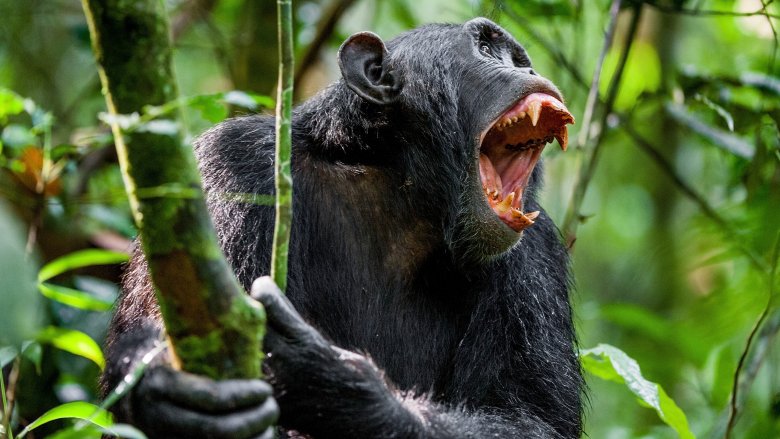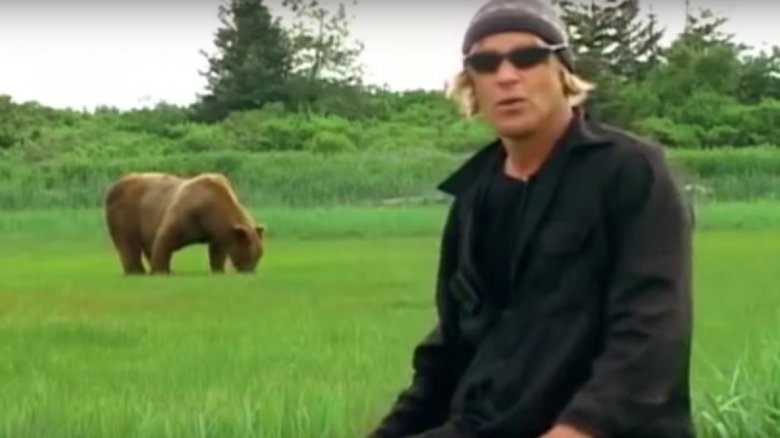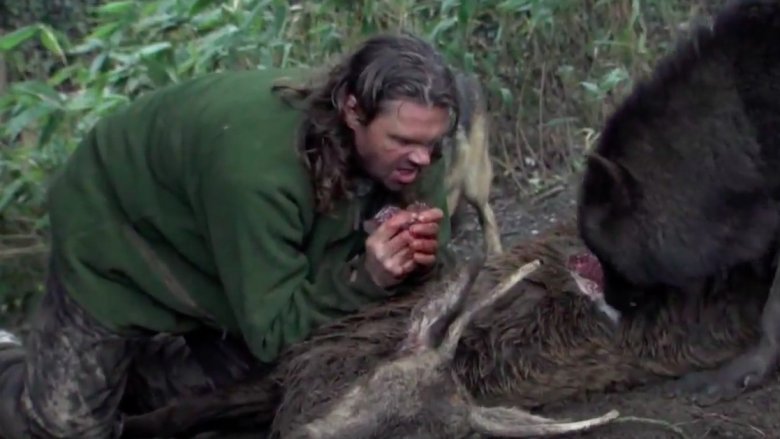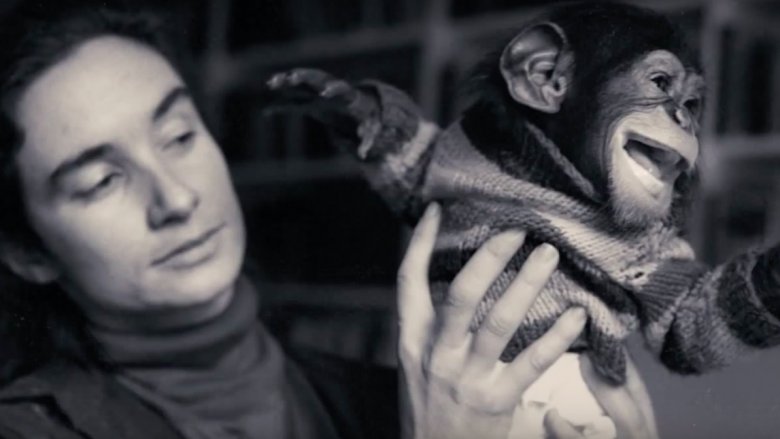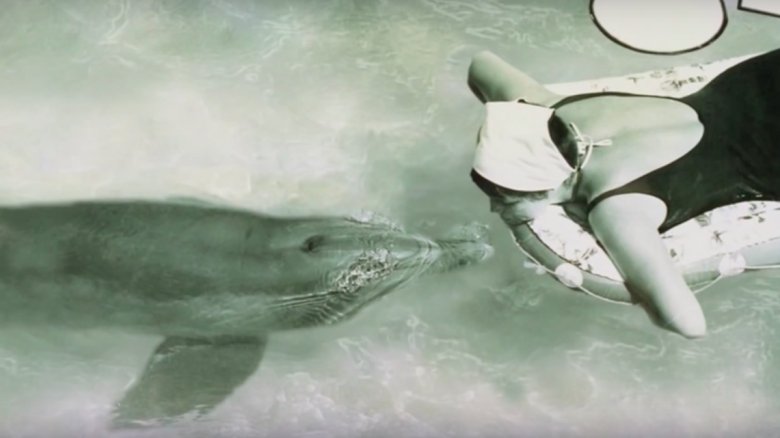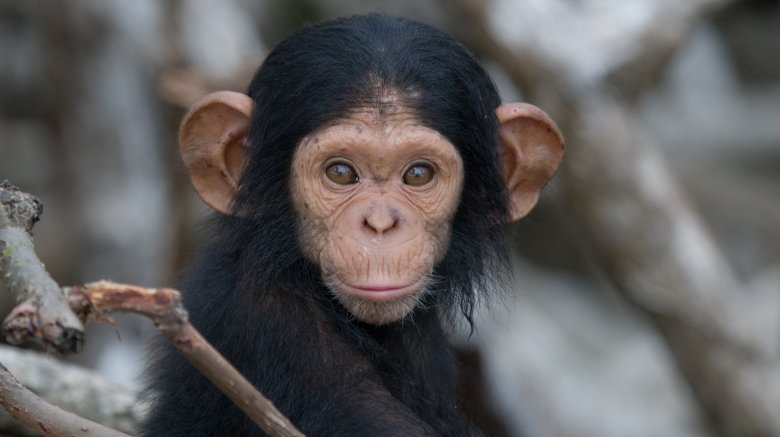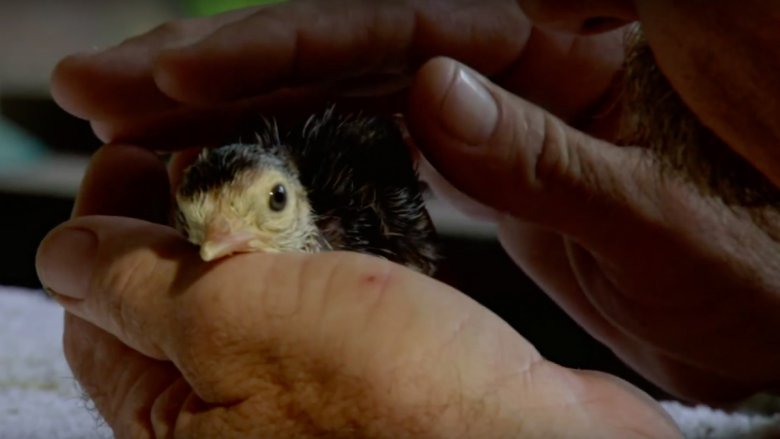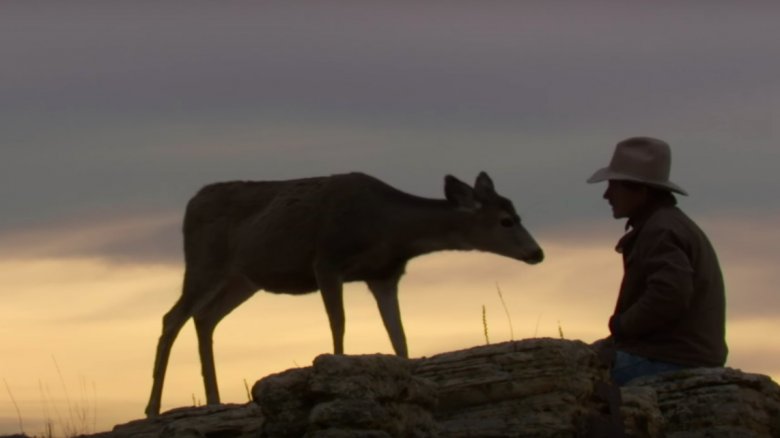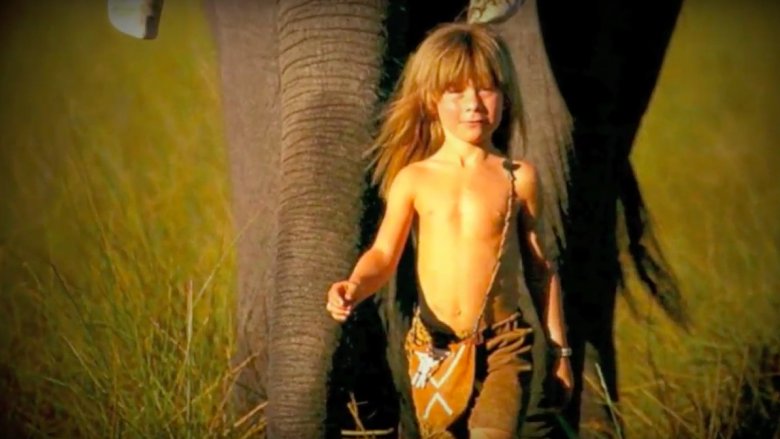Insane Stories From People Who Lived With Animals
We've all heard tales of wolf children — kids who were abandoned or lost and found sanctuary living with wild animals. Those stories are actually pretty uncommon and are often totally made up, but there are some true stories of human adults voluntarily living with wild creatures that are just as remarkable. Here are some of the most insane modern stories about people, both scientist and non-scientist, who moved in with wild animals and had totally weird, sometimes deadly experiences.
Timothy Treadwell
Most people who decide to move in with a large number of non-human animals are either scientists or just really lonely people who like cats a little too much. Timothy Treadwell was more the latter — not a scientist, but a failed actor. But the animals he liked a little too much weren't (relatively) harmless pets; they were grizzly bears.
According to his obituary, Treadwell spent 13 summers living with and studying bears in Alaska. He was controversial, partly because he lacked actual training as a research scientist and partly because he was way too confident around his quarter-ton subjects, claiming that the bears would never hurt him because they "love me too much."
Even Treadwell's defenders had to have seen that he was becoming dangerously arrogant. In 2003, Treadwell wrote a letter to an associate, which read, "My transformation is complete — a fully accepted wild animal — brother to these bears." In October of that same year, he was killed and eaten by one of his "brothers."
To be fair, the bear that killed Treadwell wasn't one he was familiar with, and it was much later in the season than he usually stayed, during a time when food is scarce and bears are working double-time to pack on an extra layer of fat before the winter. But his failure to recognize that not-so-small danger is what ultimately killed him and his girlfriend, who watched while the bear tore him apart, dragged him away, and then came back for her.
Farley Mowat
In 1946, Farley Mowat was hired by the Dominion Wildlife Service to prove that wolves were to blame for the declining caribou population in the northern Canadian wilderness. His employers hoped his research would give them a good reason to shoot wolves because everyone knows that Mother Nature made the caribou for human hunters, not for wolf predators. Mowat's employers were probably fairly annoyed when he told them that the wolves in northern Canada weren't even eating caribou, they were eating rodents. And because observation wasn't enough, Mowat had an extra layer of proof: he knew that a large predator could survive eating nothing but voles (the small rodent that populates the Arctic wilderness) because he'd done it himself. Gross.
Now, much of what Mowat wrote in the 1963 book Never Cry Wolf about his experiences in the Arctic has been more or less discredited as heavily fictionalized, but no one really disputes that the vole experiment actually happened. In fact Mowat was almost gleeful about it — The Seattle Review of Books noted that he even published his recipe for "Souris a la creme," which means "Mouse in Cream." Funny, it doesn't actually sound any more delicious in French.
James Jablon
In January 2011, Jim Jablon moved into the lion pen at Wildlife Rehabilitation of Hernando, Inc., the 14-acre sanctuary he'd owned and operated since 2002. The move was pure publicity — he hoped to raise money for his struggling nonprofit. By the end of the month, the Tampa Bay Times reported he'd collected around $75,000, which isn't bad for 31 days' work, although most people don't have jobs that require wrestling lions and sleeping outdoors in January weather conditions.
Of course, like just about everyone who mingles with wild animals and isn't a bona fide scientist, Jablon had as many critics as he had fans. According to the LA Times, people accused him of "exploiting" the big cats and treating them like pets, and then they were all, "Here's a bunch of money and a plane ticket so you can release them back into the wild instead." (Just kidding, no one said that.)
Like so many modern wildlife sanctuaries, Jablon's was struggling to make ends meet. Lions eat between 10 and 15 pounds of meat every day — imagine what that weekly trip to the grocery store looks like. Jablon's stunt didn't get him all the way to his $150,000 goal, but the money he earned was enough to pay the food bill for at least another year.
Shaun Ellis
Stories of quirky non-scientists moving in with dangerous predators don't always have to have tragic endings. When he was in his 20s, Englishman Shaun Ellis sold everything he owned to buy a plane ticket to Idaho, where he began a career as a wolf researcher. But unlike ordinary wolf researchers who are mostly happy tagging wolves with radio collars and collecting their poop, Ellis thought he could learn more if he ditched the scientific method and integrated himself into the wolves' culture, sort of like language immersion except that in most cultures they won't literally bite your face off if you mispronounce a word.
In a 2011 essay for the Guardian, Ellis wrote about his one-year experience living with a wild wolf pack. In the essay, he said he "moved to the wild" and set up camp near a wolves' den, and eventually the pack started to trust him. That seems odd given that most humans wouldn't trust some strange dude who set up camp near their kids' bedroom, but okay. The wolves came to not only accept his presence but to let him babysit their pups. They brought him tasty treats like raw deer and elk and, yes, once tried to bite his face off — he said he deserved it because he ate the filet mignon instead of the chuck roast, or something. Happily, Ellis got out alive and now runs a wolf research center in Devon, England.
Nim Chimpsky
In 1973 a baby chimpanzee named "Nim Chimpsky" was taken from his mother and placed in a human home, according to ABC News. This was the '70s, when people thought vinyl jumpsuits and double denim were groovy, man, so the sheer stupidity of trying to integrate a chimpanzee into a family of nine (Stephanie LaFarge, her husband, and their seven children) probably didn't seem quite so obvious in those days. The goal was to treat Nim exactly like a child, in the hope that he would learn human behavior and human speech. What happened, as reported by NPR, is that he learned how to bite his human siblings and smoke pot, and then he went berserk and destroyed his human "dad's" library.
Nim was eventually kicked out of his home and placed with a new mom. Then he bit his new mom and mauled someone else, and the project was over. Nim was sent to Oklahoma to live with his own kind, but at least one goal of the ill-fated Nim Project had already been met: Nim thought he was a person (an ill-behaved person, but still) and had no idea what to do around other chimps.
Years later when LeFarge tried to visit her former "son," she discovered that chimpanzees never forget. According to the Telegraph, Nim attacked her when she entered his cage and might have harmed her if someone hadn't distracted him. She later said she believed Nim meant to punish her for abandoning him.
Margaret Howe Lovatt
In this bizarre tale of a research project gone horribly, horribly wrong, a 23-year-old research scientist named Margaret Howe Lovatt moved into a flooded house to teach a dolphin how to speak. Yes, that is correct. She was going to try to teach a dolphin how to speak actual English, as reported by the Guardian.
The house was flooded so the dolphin, named "Peter," had enough room to swim around and Lovatt could wade, though she was also given a desk and a bed that were physically suspended above the water so she wouldn't have to be soggy for 24 hours a day. Not long into the project, Lovatt realized the dolphin was courting her, and since his romantic desires were getting in the way of the whole "speaking English" thing, she decided to just ... do some stuff. (She helped him out with her hand.)
Anyway, it wasn't the ultra-disturbing nature of the whole scenario that ended the project but rather the lead scientist, who was doing other unethical things, like giving LSD to the rest of the dolphins. The project ended, and Lovatt and Peter went their separate ways. But the poor love-struck dolphin never went on to form normal relationships with actual girl dolphins — instead, he fell into a deep depression and "committed suicide" by deliberately failing to surface for air. For never was a story of more woe, than this of Lovatt and that really freaking weird thing that happened with the dolphin.
Sandra Herold
In 1995, because for some reason people just will not get a clue about what a terrible idea it is to raise chimpanzees in human homes, Sandra Herold paid $50,000 cash for a baby chimpanzee she named "Travis." She and her husband, Jerry, raised Travis as if he was a child, teaching him how to brush his own teeth, use the toilet, and ride a bicycle. He became a local celebrity — even the police loved him, and just about every officer on the force had a photo taken with him. Of course nearly everyone who knew Travis failed to consider one small problem: chimpanzees are assholes.
One day, Travis got agitated and ran outside. When Herold's friend Charla Nash showed up to help corral him, he attacked her and bit her face off. And not in a "you ate my filet mignon" sort of way, but more like an "I'm a crazy chimpanzee who belongs in the jungle and I'm going to eat your face because I can" sort of way.
Charla Nash lost much of her face and both her hands in the attack that also left her blind. She survived and, according to Brigham and Women's hospital, received a full face transplant in 2009, roughly one year after her friend's 200-pound pet chimp went berserk and nearly killed her. The moral of this story? Curious George is a ticking time bomb and needs to go back to the jungle, like, today. The end.
Joe Hutto
It's fairly easy to see why someone might want to live as a wolf or as a bear, because wolves are cool. And bears are cool, though mostly just when they're not eating you. But turkeys? Sure, they won't maul you or eat your face or anything, though there might be a small risk of eyeball pecking. But living with turkeys isn't exactly glamorous, which is why Joe Hutto's year-plus "life as a turkey" (via NewScientist) is so amazing — not just because it takes a special kind of dedication to shun all human contact with nothing but your future Thanksgiving dinner for company (just kidding, Hutto didn't eat any of his turkeys), but because the cool-factor isn't that high. Actually there isn't any cool-factor at all.
Hutto's project started when a neighbor brought him some wild turkey eggs he'd found on his plantation. Hutto knew if he hatched them and wanted the poults to stay wild, he was going to be committing to something pretty crazy — he'd have to abandon everyone he knew, move out into the wilderness, and become a turkey mom. Which also meant learning how to speak turkey and wearing only pale blue (because turkey moms have pale blue heads). The Casper Star Tribune said Hutto took his job so seriously that he wouldn't eat in front of his turkeys, because turkey moms don't eat sandwiches, and he wouldn't take pictures of them because turkey moms don't scrapbook. That's dedication.
Joe Hutto (again)
After he was done with the whole turkey thing, Joe Hutto spent seven years living with mule deer, as the Casper Star Tribune reported. He didn't have to shun humans this time, though, or sleep in the wilderness because his house was right in the middle of the mule deer's winter territory.
Hutto's experience with the turkeys was invaluable for this project — he'd gotten so good at integrating with animal communities that he fooled a few of his subjects into thinking he was an actual deer, and he didn't even have to skip breakfast, lunch, and dinner to do it. According to PBS, the mule deer made "numerous displays" of affectionate behavior toward him. One mule deer once tried to butt heads with him — literally. Young bucks like to spar with other young bucks, and this one for some reason didn't notice that his sparring partner lacked antlers.
Of course one major hazard to becoming a deer with two legs and a total inability to escape predators is that your herd will sometimes bound off into the brush, leaving you to face whatever happens to be stalking it. And that's why Joe Hutto is the world's only rifle-carrying mule deer.
Tippi Degre
According to a completely unscientific statistic that we totally just made up, four out of five children wish they could grow up in Africa and be best friends with a bull elephant. For Tippi Degre, that was her actual childhood. Her parents were wildlife photographers living in Namibia. As a small child, Tippi didn't play with Barbie dolls or Tonka trucks; she played with giant toads, elephants, and lion cubs. She thought of the animals as her brothers and sisters, and was particularly close with a 5-ton, 10-foot-tall African elephant named Abu. She rode on Abu's back and on his trunk. She petted leopards, played with meerkats, snuggled toads, and rode ostriches. Since she's still living, we assume she stayed mostly away from chimpanzees.
When you consider that Tippi was a very small child during these experiences (she left the continent when she was 10), it seems pretty insane that her parents were so cavalier about letting her play with animals known for trampling humans, mauling humans, and singing Hakuna Matata — but her mom told The Telegraph that she only ever interacted with animals that were tame or accustomed to humans. Although we all know how well that worked out for Charla Nash.
George Adamson
George Adamson's nickname was "Baba ya Simba," which means "Father of Lions." Wait ... "Simba" means "lion"? Like naming your kid "Human"? Nice one, Mufasa.
Anyway, Adamson and his wife, Joy, were the couple featured in the award-winning documentary Born Free — Joy wrote the book the documentary was based on, which told the story of an orphaned lion the couple adopted in 1956. The lion, called Elsa, was the first captive-raised lion ever successfully returned to the wild.
After the book and documentary, Adamson kept on raising orphaned lions for release, but he always maintained a relationship with the animals after they went back to the wild. He would often venture out to find them, and according to the biographical website "Father of Lions," was even known to play with the wild cubs of lionesses he'd raised and released. He could approach his lions after a kill and was once photographed sitting with a male lion and the freshly killed carcass of a zebra. For most people, approaching a bunch of lions and their dead zebra is actually a pretty effective form of suicide. Definitely don't try it the next time you're on a safari.
Adamson wasn't a college-educated scientist. He was just a guy who loved lions. Because of that, he wasn't taken seriously by his contemporaries, but that never seemed to bother him. He continued his work for the rest of his life until he was killed by bandits in 1989 at the age of 83.
Maggie and Andy Robin
In 1976, Scottish wrestler Andy Robin had the brilliant idea to buy a grizzly bear cub so he could train it to be his sparring partner. What fun it would be to wrestle with a giant fuzzy teddy bear with 3-inch claws and an appetite for human flesh! Robin and his wife, Maggie, purchased Hercules the bear from a zoo in Scotland for £50, and he grew to be 9 feet tall and weigh nearly half a ton. According to the Telegraph, Robin's training philosophy went like this: show an animal enough love, and it will never hurt you. (Note: not effective for human teenagers.)
In 1980, Robin took Hercules for a swim in the Sea of the Minch, and the bear made a break for it. He was missing for 24 days, and pretty much everyone who had an opinion said it was only a matter of time before he was munching on someone's livestock, or on someone else's person, since Hercules had never been taught to fish and people and livestock were the only two other items on the menu. Instead, the bear elected to starve — when he was finally captured, he'd lost more than half his body weight. In fact the most insane thing about this story is that Hercules never killed, mauled, or injured anyone, ever. He died of natural causes in 2000.
